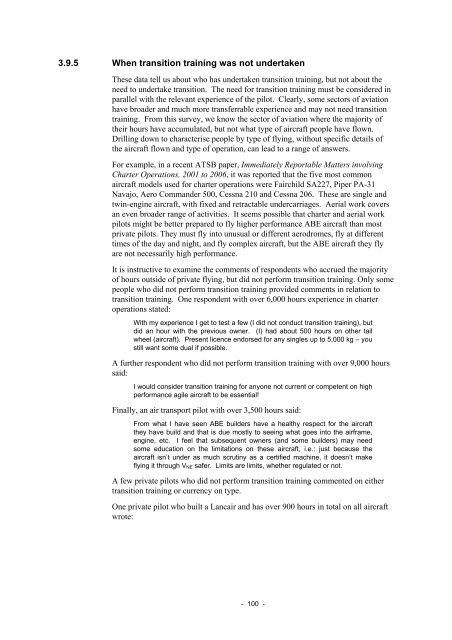Amateur-built and experimental aircraft - Australian Transport Safety ...
Amateur-built and experimental aircraft - Australian Transport Safety ...
Amateur-built and experimental aircraft - Australian Transport Safety ...
Create successful ePaper yourself
Turn your PDF publications into a flip-book with our unique Google optimized e-Paper software.
3.9.5 When transition training was not undertaken<br />
These data tell us about who has undertaken transition training, but not about the<br />
need to undertake transition. The need for transition training must be considered in<br />
parallel with the relevant experience of the pilot. Clearly, some sectors of aviation<br />
have broader <strong>and</strong> much more transferrable experience <strong>and</strong> may not need transition<br />
training. From this survey, we know the sector of aviation where the majority of<br />
their hours have accumulated, but not what type of <strong>aircraft</strong> people have flown.<br />
Drilling down to characterise people by type of flying, without specific details of<br />
the <strong>aircraft</strong> flown <strong>and</strong> type of operation, can lead to a range of answers.<br />
For example, in a recent ATSB paper, Immediately Reportable Matters involving<br />
Charter Operations, 2001 to 2006, it was reported that the five most common<br />
<strong>aircraft</strong> models used for charter operations were Fairchild SA227, Piper PA-31<br />
Navajo, Aero Comm<strong>and</strong>er 500, Cessna 210 <strong>and</strong> Cessna 206. These are single <strong>and</strong><br />
twin-engine <strong>aircraft</strong>, with fixed <strong>and</strong> retractable undercarriages. Aerial work covers<br />
an even broader range of activities. It seems possible that charter <strong>and</strong> aerial work<br />
pilots might be better prepared to fly higher performance ABE <strong>aircraft</strong> than most<br />
private pilots. They must fly into unusual or different aerodromes, fly at different<br />
times of the day <strong>and</strong> night, <strong>and</strong> fly complex <strong>aircraft</strong>, but the ABE <strong>aircraft</strong> they fly<br />
are not necessarily high performance.<br />
It is instructive to examine the comments of respondents who accrued the majority<br />
of hours outside of private flying, but did not perform transition training. Only some<br />
people who did not perform transition training provided comments in relation to<br />
transition training. One respondent with over 6,000 hours experience in charter<br />
operations stated:<br />
With my experience I get to test a few (I did not conduct transition training), but<br />
did an hour with the previous owner. (I) had about 500 hours on other tail<br />
wheel (<strong>aircraft</strong>). Present licence endorsed for any singles up to 5,000 kg – you<br />
still want some dual if possible.<br />
A further respondent who did not perform transition training with over 9,000 hours<br />
said:<br />
I would consider transition training for anyone not current or competent on high<br />
performance agile <strong>aircraft</strong> to be essential!<br />
Finally, an air transport pilot with over 3,500 hours said:<br />
From what I have seen ABE builders have a healthy respect for the <strong>aircraft</strong><br />
they have build <strong>and</strong> that is due mostly to seeing what goes into the airframe,<br />
engine, etc. I feel that subsequent owners (<strong>and</strong> some builders) may need<br />
some education on the limitations on these <strong>aircraft</strong>, i.e.: just because the<br />
<strong>aircraft</strong> isn’t under as much scrutiny as a certified machine, it doesn’t make<br />
flying it through VNE safer. Limits are limits, whether regulated or not.<br />
A few private pilots who did not perform transition training commented on either<br />
transition training or currency on type.<br />
One private pilot who <strong>built</strong> a Lancair <strong>and</strong> has over 900 hours in total on all <strong>aircraft</strong><br />
wrote:<br />
- 100 -

















